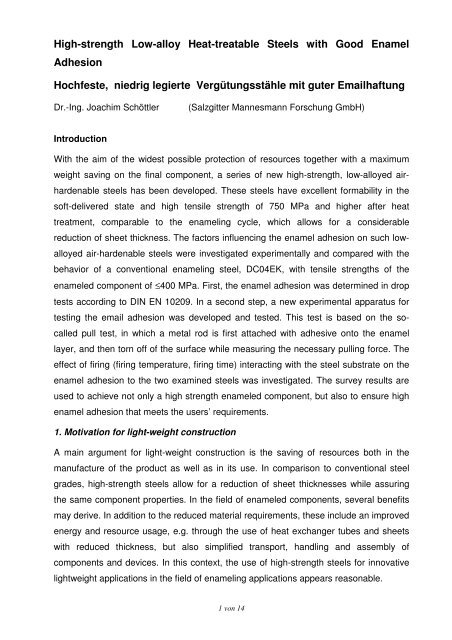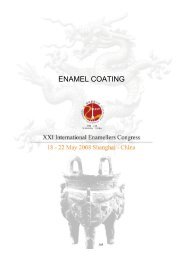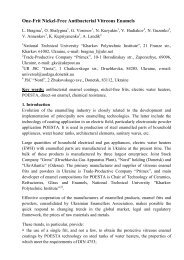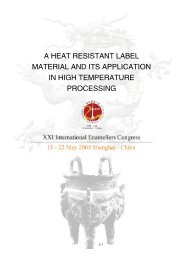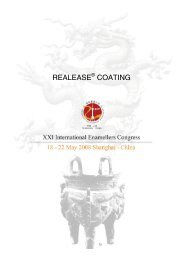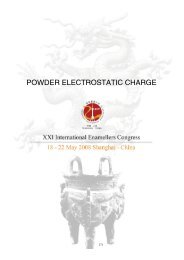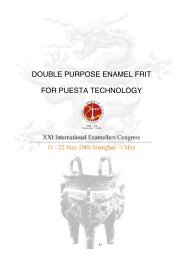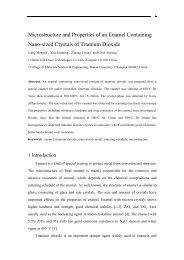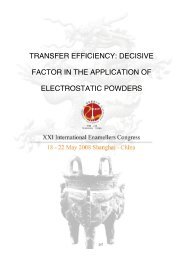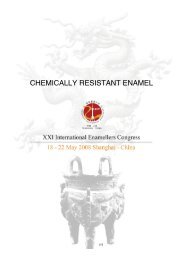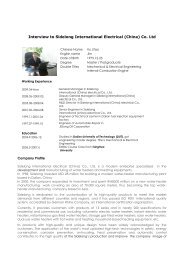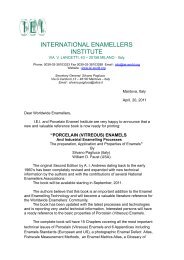High-strength Low-alloy Heat-treatable Steels with Good Enamel ...
High-strength Low-alloy Heat-treatable Steels with Good Enamel ...
High-strength Low-alloy Heat-treatable Steels with Good Enamel ...
Create successful ePaper yourself
Turn your PDF publications into a flip-book with our unique Google optimized e-Paper software.
<strong>High</strong>-<strong>strength</strong> <strong>Low</strong>-<strong>alloy</strong> <strong>Heat</strong>-<strong>treatable</strong> <strong>Steels</strong> <strong>with</strong> <strong>Good</strong> <strong>Enamel</strong>AdhesionHochfeste, niedrig legierte Vergütungsstähle mit guter EmailhaftungDr.-Ing. Joachim Schöttler(Salzgitter Mannesmann Forschung GmbH)IntroductionWith the aim of the widest possible protection of resources together <strong>with</strong> a maximumweight saving on the final component, a series of new high-<strong>strength</strong>, low-<strong>alloy</strong>ed airhardenablesteels has been developed. These steels have excellent formability in thesoft-delivered state and high tensile <strong>strength</strong> of 750 MPa and higher after heattreatment, comparable to the enameling cycle, which allows for a considerablereduction of sheet thickness. The factors influencing the enamel adhesion on such low<strong>alloy</strong>edair-hardenable steels were investigated experimentally and compared <strong>with</strong> thebehavior of a conventional enameling steel, DC04EK, <strong>with</strong> tensile <strong>strength</strong>s of theenameled component of ≤400 MPa. First, the enamel adhesion was determined in droptests according to DIN EN 10209. In a second step, a new experimental apparatus fortesting the email adhesion was developed and tested. This test is based on the socalledpull test, in which a metal rod is first attached <strong>with</strong> adhesive onto the enamellayer, and then torn off of the surface while measuring the necessary pulling force. Theeffect of firing (firing temperature, firing time) interacting <strong>with</strong> the steel substrate on theenamel adhesion to the two examined steels was investigated. The survey results areused to achieve not only a high <strong>strength</strong> enameled component, but also to ensure highenamel adhesion that meets the users’ requirements.1. Motivation for light-weight constructionA main argument for light-weight construction is the saving of resources both in themanufacture of the product as well as in its use. In comparison to conventional steelgrades, high-<strong>strength</strong> steels allow for a reduction of sheet thicknesses while assuringthe same component properties. In the field of enameled components, several benefitsmay derive. In addition to the reduced material requirements, these include an improvedenergy and resource usage, e.g. through the use of heat exchanger tubes and sheets<strong>with</strong> reduced thickness, but also simplified transport, handling and assembly ofcomponents and devices. In this context, the use of high-<strong>strength</strong> steels for innovativelightweight applications in the field of enameling applications appears reasonable.1 von 14
2. Change of steel properties during heat treatmentFrom the perspective of enameling applications, the use of conventional high-<strong>strength</strong>steels seems questionable because the mechanical properties of most of these steelsare ensured by thermomechanical treatment during hot rolling and/or final annealingprocesses. The enamel firing, at temperatures above 850°C, results in a softening of themicrostructure and a reduction of <strong>strength</strong> of these steels, which is significantly morepronounced than in normalized rolled steels [1]. This trend becomes stronger <strong>with</strong> anincreasing initial <strong>strength</strong> level. With multiple firing this trend worsens, so that thematerial loses <strong>strength</strong> steadily. Regarding enameling applications, this illustrates ademand for steels <strong>with</strong> high <strong>strength</strong> after enamel firing.To take advantage of light-weight construction in the area of enameling applications, aseries of innovative air-hardenable steels (LH ® steels for common applications and EHfor enameling needs) have been developed, which combine excellent formability in thesoft-delivered state, <strong>with</strong> high <strong>strength</strong> after heat treatment comprising of heating up intothe austenitic region followed by relatively slow cooling (e.g. analogous to enameling).These steels are distinguished by the fact that they not only don’t lose <strong>strength</strong> aftersuch a heat treatment, but even gain <strong>strength</strong> due to the air-hardening effect. As shownin Fig. 1, the achievable mechanical properties of EH800 depend on the heatingconditions such as temperature (820°C or 870°C) and furnace holding time (4 min or 7min). For comparison, the results for the soft-delivered state are given as V1.Fig. 1: Tensile test results for EH800 after enameling <strong>with</strong> different heating conditionsCompared to the delivery condition, after enameling <strong>with</strong> firing temperatures of 820°C,yield <strong>strength</strong> (YS) and tensile <strong>strength</strong> (TS) values increase by approx. 50 %, and <strong>with</strong>firing temperatures of 870°C even by up to 100 %. This occurs due to more γ-Fe being2 von 14
formed at higher temperatures which promotes the formation of a martensitic or bainiticsteel structure and therefore higher <strong>strength</strong>. Time has the same, however, smallerimpact as the above mentioned firing temperature. <strong>High</strong>er firing time gives the structuremore time to form austenite. Due to the fact that this is a steel micro<strong>alloy</strong>ed <strong>with</strong> Ti andV, the possibility of <strong>strength</strong>ening through precipitation of Ti and V carbonitrides isanother domain. With an increase in time the harder precipitations can distributethemselves subtly thus creating a stronger microstructure. In general, a raise intemperature and/or time decreases the ductility and fracture strain of the material.The typical mechanical characteristics of the air-hardenable enameling steel EH800before and after enameling are:As-delivered: YS: 280 - 400 MPa TS: 450 - 570 MPa El: 24 - 30 %After enameling: YS: 500 - 650 MPa TS: 700 - 900 MPa El: 15 - 23 %3. <strong>Enamel</strong>ability of air-hardening steel EH800Among the basic requirements of a good enamelability of steel sheets is a resistance tothe formation of “fish scale” defects, caused by an excessive quantity of hydrogen at theinterface steel/enamel. The excellent fish-scale resistance of EH800, even in doublesideenameling of hot-rolled sheets, has already been reported on in a former paper [1].The primary cause of this is the increased content of precipitation products in the formof titanium and/or vanadium carbonitrides in the microstructure of the steel, effectivelyserving as hydrogen traps.The enamel adhesion on EH800 is comparable to conventional enameling typeDC04EK, if appropriate pre-treatment is provided. Nevertheless, in a few cases ofindustrial tests, an insufficient enamel adhesion was noted. Therefore, a researchprogram to investigate the fundamental factors influencing the enamel adhesion onEH800 sheets was started in co-operation <strong>with</strong> the Monash University, Australia. Themain results of the tests are summarized in the following sections.4. Investigation of enamel adherenceThe basic idea of this research program was to observe processes and phenomena<strong>with</strong>in the enamel and steel and link changes to specific manufacturing parameters aswell as macroscopic properties (in essence adhesion).The examinations were performed <strong>with</strong> the variation of the following parameters:• Steel quality - EH800 and DC04EK as comparative material• Firing temperature - 820°C or 870°C3 von 14
• Firing time - 4 min or 7 min• Type of enamel frit - direct-on white test enamel based on the Ferro 17206frit, or boiler direct frit Ferro G 292Two identical 100 mm x 100 mm plates were made for every possible parameterconstellation as well as the separate tensile test samples.The specific features of the interface between steel and enamel were examined bymicroscopy and SEM.Optical MicroscopyThe aim of the optical microscopy examinations was to distinguish obviouscharacteristics at the steel-enamel boundary layer and point out their development <strong>with</strong>respect to the used manufacturing parameters. Considering the results, someobservation classifications that have potential impact on adhesion properties weremade:• Wideness of intermediate layer• Stick shaped titanium oxide crystals when using direct-on white enamel• Steel surface/roughnessWideness of intermediate layerThe dimensions of the intermediate layer were defined as the distance between thesteel surface and the point where the homogeneous enamel starts. Temperature seemsto have a strong impact on the wideness of intermediate layer. Wideness increases <strong>with</strong>temperature for EH800 and it decreases for DC04EK by rather similar magnitude. Thetendency of increase in wideness is also visible for the effect of longer times on EH800,however the impact is significantly smaller and seems to decline steadily.Titanium oxide crystalsWhen using direct-on white enamel, the formation of stick shaped FeTiO 3 crystals onsteel surfaces was observed. In general, both steels show the clear tendency to reducethe total amount of Ti-crystals <strong>with</strong> a rise in temperature and time, whereas, longertimes have a much lighter but still recognizable impact.Steel SurfaceThe steel surface itself has a significant impact on adhesion properties. Mechanismslike mechanical gearing, amount of chemical bonds, or electrostatic attractions are4 von 14
linked to the surface properties of the parent metal. Specifically in terms of mechanicalgearing, the roughness of the surface is a meaningful criterion. More surface perexamination width causes an obvious increase in all of the mentioned characteristics, sotherefore a simple measurement of the 2-D surface length is representative. This length,L, divided by the wideness of the examined image, B, displays a universal comparablerelation. L was established by examining 6 images per parameter configuration using amap distance reader.Surface roughness of EH800 <strong>with</strong> the test enamel remains constant throughout thechanges in parameters and constantly has the lowest ratio for all combinations of steeland enamel. Roughness for EH800 <strong>with</strong> the boiler enamel increases <strong>with</strong> temperature.The same applies for a longer firing time at 820°C but the ratio declines for longer timesat 870°C. However, it still has a higher ratio than at 820°C and 4 min. In general,DC04EK has a higher surface roughness than EH800. Here also, L/B increases <strong>with</strong>temperature.Fig. 2:Different phenomenological behaviors at the steel-enamel interface (100x)Top left: Detachment of nickel coating (EH800, test enamel, 820° C, 4 min);Top right: Much more rugged detachment of steel surface (EH800, boiler enamel, 870° C, 7min);Bottom left: Only slight detachment of nickel coating <strong>with</strong> a tendency of dissolving (DC04EK,test enamel, 820°C, 4 min);Bottom right: Dissolving of steel surface and visible minor steel particles (DC04EK, boilerenamel, 870°C, 7 min)5 von 14
The steels also show different phenomenological behaviors at the steel-enamelinterface: either a continuous detachment, or dissolving of the outer layer. In essence,the different types of surface processes are induced by the choice of steel and enameland not by the experimental parameters. However, the magnitude of thesephenomena may be influenced by such (i.e. dissolving of steel for DC04EK <strong>with</strong> boilerenamel).EH800 has the strong tendency to separately detach its nickel coating (EH800, testenamel) as an "island chain" and "release" it into the enamel or where no nickel isapplied, into the outer steel layer, Fig. 2 Top. This outer steel layer, however, is muchmore rugged and consists of many more (especially smaller) components. Sporadically,there are areas of dissolution which is also a strong distinction to the nickel coating. Ageneral overview of all EH800 <strong>with</strong> boiler enamel images shows no obvious effect oftemperature or time on either magnitude or distance of detachment.DC04EK shows a severe "acid-like" dissolving of the surface. Even the nickel coatedtest enamel samples only show a minor (if at all) detachment of the nickel layer.SEMSEM was conducted on EH800 steel <strong>with</strong> both enamel types. The aim here wasprincipally to get clarification on chemical compositions. The most important procedurewas the usage of linescans throughout the different characteristic zones of thecomposite material.Main components of the intermediate layer are Fe, O, Si and C. The most importantresult as given in Fig. 3 and Fig. 4, is that the globular particles of boiler enamelsamples are iron-based and in addition contain Si, O and C.6 von 14
Fig. 3:Display of boiler enamel linescan <strong>with</strong> tagged characteristic components7 von 14
Fig. 4:Chemical composition of globular crystals (brown) and boiler enamel (red)Adhesion TestsThe aim of adhesion tests is to receive a quantitative magnitude of mechanicaladhesion of the enamel on the steel surface. First thoughts were given to astandardized drop test (prEN 10209:2010). This delivers results based on an opticalcomparison and categorization in adhesion classes of 1 - 5. Due to a high error potentialand the fact that a significant amount of results were nonevaluative, a speciallyconstructed device was built. After considering the pros and cons of other adhesiontesting methods the Pull Test was chosen as a basis for examinations and the finaldevice is presented in Fig. 5. It is attached to a conventional tensile test machine andthe replaceable rods are glued to the samples and pulled off vertically. 'Ultra Bond 100'manufactured by 'Dr. Karlis Gross’ was used as the adhesive. It and the connectedsample were heat-treated at 150°C for 90 min. Test velocity was a constant 0.25mm/min. The results of this test are tension values representing the adhesioncharacteristics that are relative to each other. A total of 4 tests per parameterconfiguration were conducted. As an example of the scattering of the measured results<strong>with</strong>in one parameter configuration, this compilation is given in Fig. 6 for thecombination EH800 steel and boiler enamel.8 von 14
Fig. 5:Sketch of self designed adhesion pull testFig. 6 shows that vertically tearing off the enamel mostly deviates from the expectedstiff elastic tensile test behavior. Because of the brittle properties of enamel, a steadystraight slope <strong>with</strong> a rapid tension plunge right after maximum tension was anticipatedbut due to the presumed inequalities <strong>with</strong> the adhesion of the adhesive, and resultingmoments (shearing) linked to the device and sample geometry (deformed after previousdrop tests) results are different. One can recognize the frequent non-linear rises intension (probably, the plasticity of the adhesive) and often local tension dips and rises(cant/jamming/shearing) that result in severe variations of the graphs <strong>with</strong>in oneparameter configuration. Another distinction is the fluctuation of qualitative pull distance(x-axis), which is also likely a result of the elastic properties of the adhesive. Anexamination of the standard deviation suggests that these results should be interpreted<strong>with</strong> caution. In addition as already mentioned, the actual enamel detachment staggersstrongly as well.9 von 14
Fig. 6:Compilation of the different results for each parameter constellation <strong>with</strong> EH800 steel andboiler enamelDespite the mentioned experimental criticism, thoroughness of detachment has astrikingly clear tendency. It is clearly effected by steel-enamel combination and not bythe used parameters. Also, the more the enamel detaches thoroughly, the less of ascattering of the individual values is observed (Tab. 1). The tendency that the tensilesamples <strong>with</strong> higher detachment thoroughness also have higher maximum stressvalues <strong>with</strong>in the same parameter configuration, seldom if never applies. Samples <strong>with</strong>the same rating also do not have similar values. Issuing factors for the maximum stressvalues considering their validity is therefore futile.10 von 14
Parameters Sample Max. Stress Mean Max. Stress Rating Mean RatingLH800 1 1 1,00 4820° C, 4 min. 1 1 b 0,53 4,51,38Testenamel 1 2 3,36 23,881 2 b 0,63 5LH800 1 3 1,41 4820° C, 7 min. 1 3 b 2,07 51,82Testenamel 1 4 2,45 2,53,501 4 b 1,34 2,5LH800 1 5 1,07 2,5870° C, 4 min. 1 5 b 1,65 41,50Testenamel 1 6 1,01 43,131 6 b 2,29 2LH800 1 7 2,68 1,5870° C, 7 min. 1 7 b 1,88 51,98Testenamel 1 8 1,14 43,881 8 b 2,22 5LH800 1 9 0,48 2,5820° C, 4 min. 1 9 b 0,55 1,51,25Boilerenamel 1 10 1,68 2,52,751 10 b 2,28 4,5LH800 1 11 2,24 2,5820° C, 7 min. 1 11 b 1,27 2,51,39Boilerenamel 1 12 0,94 33,131 12 b 1,09 4,5LH800 1 13 1,35 3870° C, 4 min. 1 13 b 1,60 51,73Boilerenamel 1 14 2,03 2,53,501 14 b 1,95 3,5LH800 1 15 1,33 3870° C, 7 min. 1 15 b 2,99 3,52,61Boilerenamel 1 16 3,35 1,52,881 16 b 2,79 3,5Parameters Sample Max. Stress Mean Max. Stress Rating Mean RatingDC04EK 2 1 2,16 2,5820° C, 4 min. 2 1 b 0,34 2,51,09Testenamel 2 2 1,02 1,52,252 2 b 0,86 2,5DC04EK 2 3 1,27 1,5820° C, 7 min. 2 3 b 2,12 31,30Testenamel 2 4 0,62 32,752 4 b 1,18 3,5DC04EK 2 5 1,61 2870° C, 4 min. 2 5 b 1,55 2,51,44Testenamel 2 6 0,68 22,632 6 b 1,90 4DC04EK 2 7 1,28 1870° C, 7 min. 2 7 b 2,03 2,51,36Testenamel 2 8 0,86 22,132 8 b 1,27 3DC04EK 2 9 1,06 1,5820° C, 4 min. 2 9 b 0,64 1,50,84Boilerenamel 2 10 0,09 1,51,382 10 b 1,57 1DC04EK 2 11 0,63 1,5820° C, 7 min. 2 11 b 0,65 1,50,89Boilerenamel 2 12 0,48 1,51,382 12 b 1,81 1DC04EK 2 13 0,77 1870° C, 4 min. 2 13 b 0,41 1,50,53Boilerenamel 2 14 0,75 11,252 14 b 0,19 1,5DC04EK 2 15 0,91 1870° C, 7 min. 2 15 b 1,26 1,50,88Boilerenamel 2 16 0,52 1,51,382 16 b 0,82 1,5Tab. 1: Measured values of maximum stress for tearing off the enamel and rating for thoroughness ofenamel detachment from steel (1 = very good, 5 = very bad)Despite these variations, the mean values of the maximum <strong>with</strong>drawal stresses weredetermined for each parameter constellation (Fig. 7).Fig. 7:Overview of mean maximum stress for adhesion tests for all steel and enamel types andparameter configurationsA comparison of these averages for the various parameter combinations <strong>with</strong> theadhesion ranking values previously determined in the drop tests, provides a moremeaningful picture (see Fig. 8). It clearly demonstrates that samples <strong>with</strong> thoroughenamel separation (higher rating = poor enamel adhesion) have higher mean values ofthe maximum <strong>with</strong>drawal tension. The only real point of discontinuity in this graph is11 von 14
'EH800, boiler enamel, 870° C, 7 min.' which in addition also has the most outstandingadhesion properties.Fig. 8: Correlation between thoroughness of enamel detachment (rating) and adhesion <strong>strength</strong> (lightercolor means better rating, darker means worse)Based on the experiences made <strong>with</strong> this self-made test type, the test has the potentialto deliver representative adhesion results. Despite the strong scattering of results, thistest still has a substantial regularity and significance considering this research.However, the following ideas for improvement are recommended:• use of completely flat samples (not pre-used drop test samples) to preventunwanted shearing or moments,• use of the strongest adhesive possible <strong>with</strong> a similar Young's Modulus as enamelto prevent different elastic behaviors during the test,• if possible applying additional pressure to samples or using adhesives that do notrequire this.Correlation of Individual ResultsSince all parameter constellations gave representative results concerning themicrostructure of the steel/enamel interface and the adhesive <strong>strength</strong> of the enamel,possible correlations between the single most important results of these studies wereexamined.12 von 14
The analysis reveals that generally, adhesion increases <strong>with</strong> higher surfaceroughness. Similar combinations of steel and enamel show an obvious arrangement ingroups, while the positioning <strong>with</strong>in these combinations varies.Further, a raise of temperature and holding time always results in an increase ofadhesion (similar magnitude) for the EH800 steel.The width of the transition layer between steel and enamel, and the occurrence of thementioned titanium oxide crystals then using direct-on white test enamel, have noimpact on the adhesion <strong>strength</strong> of enamel on steel, wherein the adhesive <strong>strength</strong> ofthe direct-on white enamel was generally worse than that of the boiler emails.5. ConclusionFor lightweight construction in enameling applications, innovative air-hardenable steel<strong>with</strong> excellent formability in the soft-delivered state and high <strong>strength</strong> after a relativelyslow cooling from the austenite region was developed and investigated regardingenamel adhesion. First, the enamel adhesion was determined in drop tests according toEN 10209. In a second step, a new experimental apparatus for testing the emailadhesion by measuring the <strong>with</strong>drawal stress was developed and tested. The studyresults show the complexity and variety of factors influencing the email adhesion on thesteel surface. The main results can be summarized as follows:1) The combination steel-adhesive-enamel only in several cases (and even here onlyapproximately) behaves like an ideal brittle material.2) Scattering of adhesion test results is rather extreme (mean standard deviation ≈ 50%), however mean adhesion results can successfully be linked to certain examinationresults.3) Improved enamel adhesion is not associated <strong>with</strong> higher maximum <strong>with</strong>drawal stressof the enamel from the steel surface in the pull-test.4) A raise in temperature and furnace holding time consistently improves enameladhesion on EH800 steel.5) With increasing roughness of the steel surface the enamel adhesion improves.6) Wideness of intermediate layer shows no general correlation <strong>with</strong> adhesive <strong>strength</strong>.7) The new test type has potential but improvements have to be made to ensure thecredibility of the results.The enamel adhesion on EH800 is comparable to conventional enameling typeDC04EK, if appropriate pre-treatment is provided. Promising areas of application forhigh-<strong>strength</strong>, enameled components made of air-hardenable steel appear to be in the13 von 14
manufacture of tanks and silos for farming or biogas plants, or production of heatexchangers and water heaters. Here, the <strong>strength</strong> increase enables a sheet thicknessreduction of up to 40%, combined <strong>with</strong> an enormous weight reduction effect.AcknowledgementsThe author is indebted to the staff members of Monash University for giving laboratoryfacilities to carry out the described research work. Thanks are especially due JohannesTlatlik of RWTH Aachen for organizing and performing the tests and analyzing theexperimental results, and Professor Yuri Estrin and Professor Christopher Hutchinson ofMonash University for their helpful advice throughout the course of the tests.Bibliography[1] J. Schöttler: Einsatz von Vergütungsstählen und Nutzung ihrer Verfestigungspotenziale fürEmailanwendungen, Mitt. DEV 57 (2009) 6, P. 98-103Figures and Tables:Fig. 1:Fig. 2:Fig. 3:Fig. 4:Fig. 5:Fig. 6:Fig. 7:Fig. 8:Tensile test results for EH800 after enameling <strong>with</strong> different heating conditionsDifferent phenomenological behaviors at the steel-enamel interfaceDisplay of boiler enamel linescan <strong>with</strong> tagged characteristic componentsChemical composition of globular crystals (brown) and boiler enamel (red)Sketch of self designed adhesion pull testCompilation of the different results for each parameter constellation <strong>with</strong> EH800 steel andboiler enamelOverview of mean maximum stress for adhesion tests for all steel and enamel types andparameter configurationsCorrelation between thoroughness of enamel detachment (rating) and adhesion <strong>strength</strong>(lighter color means better rating, darker means worse)Tab. 1:Measured values of maximum stress for tearing off the enamel and rating for thoroughness ofenamel detachment from steel (1 = very good, 5 = very bad)14 von 14


